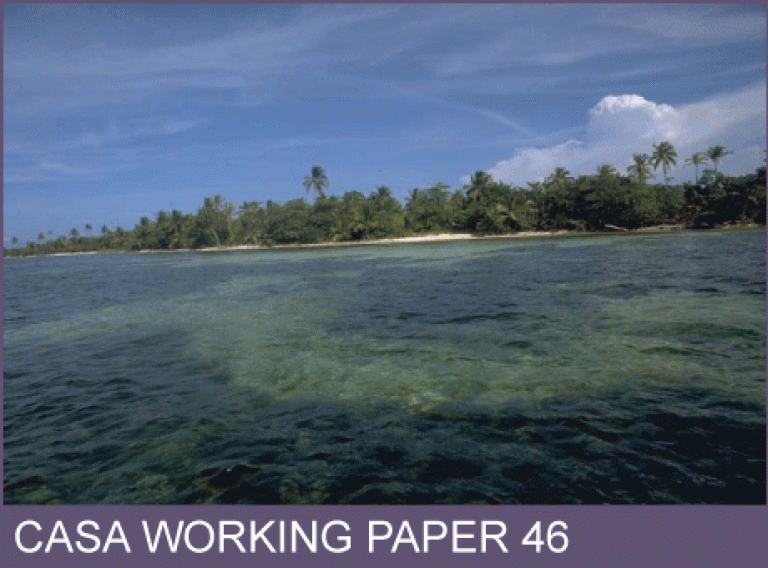CASA Working Paper 46

1 February 2002
Summary of Coral Cay Conservation's Habitat Mapping Data from Utila, Honduras
The coral reefs of Honduras are of vital national and international importance, both ecologically and economically, but are threatened because of rapid economic and population growth.
- During work on Utila between 1999 and 2000 (the 'Bay Islands 2000' project), Coral Cay Conservation developed a programme of surveys, training and conservation education aimed at assessing the status of local reefs and improving environmental awareness amongst neighbouring communities.
- This summary report provides an overview of the habitat mapping data collected by the Bay Islands 2000 project.
- CASA provided software, hardware and skills, on a charitable basis to ensure that the data collected by CCC could be developed into a GIS, not only for mapping the status of the coral reefs of Honduras, but also to provide analysis of the aerial extent of these reefs.
- Data were collected within individual 'study areas', to facilitate analysis at a range of spatial scales, and utilised the CCC standard baseline survey technique for the rapid assessment of the characteristics of reef communities. The surveys, therefore, utilised a series of transects, perpendicular to the reef.
- Baseline transects discriminated nine benthic and six geomorpholgical classes which indicates Utila has a high habitat diversity. Habitat diversity is important since the number of habitat types has been shown to be a good representation of species biodiversity.
- The nine benthic classes that were distinguished were all relatively coral poor because of a suite of relatively long-term local and regional factors, exacerbated by the combination of Hurricane Mitch and coral bleaching in 1995 and 1998.
- Damselfish were the most abundant reef associated fish recorded during baseline transect surveys. Commercially important fish were less abundant that would normally be expected in unfished systems.
- A recurring pattern in the baseline transect data was the greater abundance and diversity of fish in coral rich classes. However, although the link between fish abundance and coral cover was clear, not all species were necessarily most abundant in the most coral rich areas.
- Invertebrates were generally uncommon, partly because of fishing pressure, and the abundances of many invertebrate taxa were correlated with coral cover.
- A habitat map is presented within this report as an indication of the distribution of habitat types around Utila.
- Using the map, estimates of areal extents of each benthic class and habitat type are instructive. For example, there is only approximately 27 km2 of reefal habitats around Utila. Furthermore, the area supporting the most coral rich benthic classes is only approximately 4 km2 (15%). These statistics both highlight the damage caused by the bleaching event and Hurricane Mitch and other anthropogenic impacts and the need to conserve remaining coral rich areas.
- If further reserves were to be created, it would be important to try to protect a range of reef and habitat types. For this reason, it appears that the Turtle Harbour Wildlife Refuge is well placed since this areas includes a wide range of habitat types. However, placement of reserves in Utila should favour relatively coral rich habitats over sand dominated areas.
- This study led to six recommendations:
- One or more agencies should collect additional ground-truthing data from around Utila to facilitate both classification of currently 'Unknown' polygons and an accuracy assessment of the map.
- Establish an integrated GIS and associated meta-database for Utila, including data from the Bay Islands 2000 project.
- Examine the potential of using data collected by the Bay Islands 2000 project as the basis of national habitat classification scheme and subsequent national habitat map.
- Continue to aim to establish one or more additional multiple use marine protected areas around Utila, with an integrated monitoring programme to measure their efficacy, and strengthen the enforcement of regulations in the Turtle Harbour Wildlife Sanctuary. Establish regulations, and enforce existing legislation, to minimise the detrimental effects of coastal development on reef health.
- Additional marine reserves in Utila should integrate factors such as the preference of many fish species for coral rich habitats and the protection of areas incorporating a range of habitat types, including mangroves and seagrass beds, in order to allow for nursery areas, ontogenetic shifts and species that rely on non-coral rich habitats. The corollary of the preference of fish species for coral rich habitats is to protect coral cover within the reserves.
- The reef on the south coast of Utila appears to be a good candidate for protection because it is relatively sheltered from storm and hurricane damage.
This working paper is available as a PDF. The file size is 972KB.
Authors: Steve Evans
Publication Date: 1/2/2002
 Close
Close

